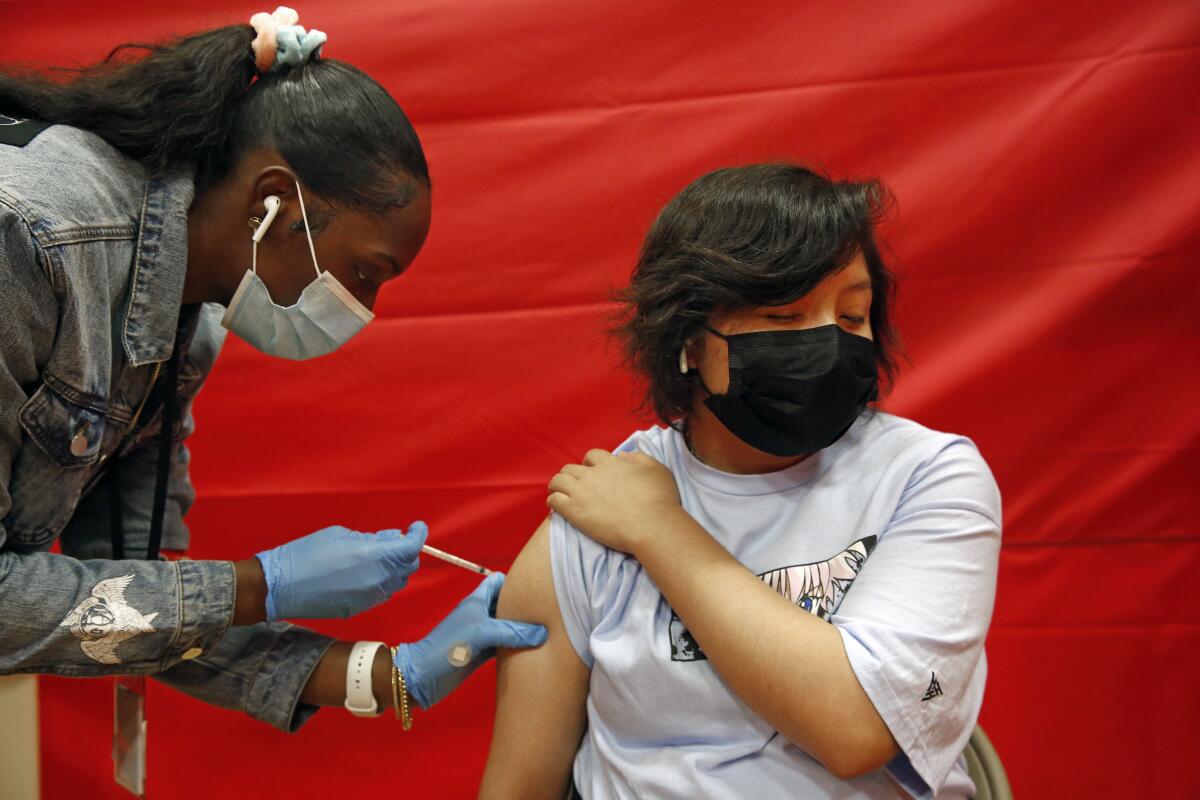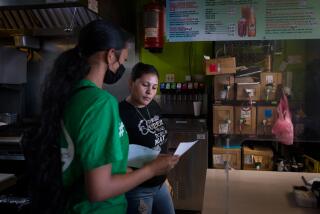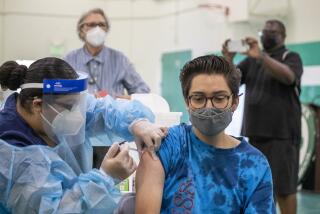Prizes, contests, cash, a Mighty Mule cheer. LAUSD to offer students vaccine incentives

- Share via
If it takes a mule to kick student vaccinations into gear, Los Angeles school leaders are willing to give it a try.
The L.A. Unified School District is poised to launch a sweeping effort to immunize about 300,000 students at 250 campuses against COVID-19, which officials see as a crucial public health strategy and a vital tactic to lure students back to badly needed in-person schooling. But they worry that simply arriving at neighborhood schools with Pfizer doses won’t be enough to reach students 12 and older — and their parents.
They need incentives, prizes, contests, cash grants — and at Wilson High School in El Sereno, the energy of their “Mighty Mule.” The mascot and other representatives of the school, such as teachers and other staff, are trusted, familiar, even popular. They could prove effective public health ambassadors.
“Everyone will listen to the mule — and teachers who are in daily dialogue with their students,” Supt. Austin Beutner said Monday during a news conference at Wilson.
Beutner’s motivation to pull out stops is well founded.
The news conference, which highlighted new job opportunities with Amazon for LAUSD graduates, included Wilson seniors who expressed gratitude for the employment connection, but also opened up about ongoing health worries. Not one of three seniors interviewed returned to campus when Wilson reopened its doors, even though all had struggled with a year of online learning.
The entire family of Daniel Enriquez came down with COVID-19 in December, and it was scary given his 8-year-old brother’s asthma and grandmother’s various ailments. Even though all the adults now have been vaccinated, “my parents were not comfortable with us coming back to school.” A vaccine for his little brother — when it is available — could make a difference in the family’s thinking: “I think they’re just waiting for him to get his vaccine, and then he’ll go to school.”
They might have to wait a while, because the approval for ages 12 to 15 came through only last week, with younger children not yet eligible.
Vaccine availability also is important for Christian Mendoza and his 15-year-old sister — because of their mother, who is vaccinated but immunocompromised after becoming ill.
So far, the nation’s second-largest school system has 19 school-based clinics; the student vaccination push is expected to reach every middle and high school through mobile operations.
Arlin De Leon said her parents are not yet ready for family members to be vaccinated. They were especially concerned after hearing reports about extremely rare but serious complications from the Johnson & Johnson vaccine.
They are far from alone in their reluctance. Only about one-third of Latino and Black Californians have received at least one dose of a COVID-19 vaccine, while majorities of white and Asian American and Pacific Islander Californians have, according to a recent Times analysis.
Latino and Black students make up about 90% of district students, and most of these students have yet to return to campuses, which reopened in a staggered schedule starting the week of April 12. According to figures from last week, about 30% of elementary students have returned. The figure for middle schools is 12%; for high schools 7%.
At the middle and high school level, the format also is an issue: Students who return to campus must remain in the same classroom all day, where they log in to classes online, the same as they would from home. The instructor in the room is working online as well, teaching a separate schedule of courses to students at home and scattered across campus.
The summer school schedule will be different, offering in-person instruction at all grade levels. High school students will have the option to take two classes in person and two additional classes online if they wish. And all families will continue to have the option of an online-only program.
The fall schedule is likely to have two major components: either a regular, full-time schedule or a predominantly online schedule. L.A. Unified, like other school systems, is expected to move away from hybrid plans that split the traditional school hours between on-campus and at-home schedules.
Beutner wants to reach students before they leave for the summer. And he’s prepared to offer them incentives, such as cash grants for campuses that achieve a still-to-be-determined vaccination rate.
“When that portion of students in the school have been vaccinated, that school wins the money,” Beutner said, outlining his concepts. “The money can be invested only at that school, in the manner the students choose. All of a sudden, they’ll have dollars they could use to put in a garden, paint a new mural, buy the cheer team uniforms, hold the dance — whatever it is students would think meaningful: Let them decide.”
“We want them engaged,” he added. “We want them activating. We want them talking with each other about their questions or concerns about vaccination,” Beutner said.
There was additional news for seniors. Beutner announced that in-person graduations — held outdoors and socially distanced — would return, although the details are being worked out.
And, after they graduate, students will have one additional option to help make ends meet while in college: entry-level job openings at Amazon.
The corporate giant is filling entry-level jobs all the time, but these particular positions come with a pledge of flexible schedules to work around college academic commitments.
That’s a potentially important opportunity, said Christian, the Wilson High senior whose mother became ill. He’d worried over the last year about having to drop out to support his family. He’ll make it through high school, but his family’s financial challenges are continuing.
With the right job to get by, he’s optimistic he’ll achieve his dream of moving from community college to a four-year school in pursuit of a career in civil engineering.
With a flexible work schedule, “I’ll be available for my mom, and I’ll be able to provide for my family at the same time,” he said.
More to Read
Sign up for Essential California
The most important California stories and recommendations in your inbox every morning.
You may occasionally receive promotional content from the Los Angeles Times.











